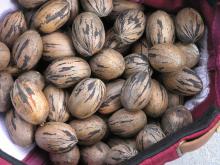Information Possibly Outdated
The information presented on this page was originally released on September 23, 2011. It may not be outdated, but please search our site for more current information. If you plan to quote or reference this information in a publication, please check with the Extension specialist or author before proceeding.
State pecan trees weather the drought
By Karen Templeton
MSU Ag Communications
MISSISSIPPI STATE – The summer drought could have severely affected this year’s pecan yields, but thanks to Tropical Storm Lee, growers are optimistic about the crop.
The entire Southeast experienced a dry growing season until Tropical Storm Lee hit in early September.
“The rains were very timely and needed,” said David Ingram, plant pathologist with the Mississippi State University Central Research and Extension Center in Raymond.
Orchards received varying amounts of rain, with many getting more than enough and others getting the bare minimum.
“In our part of the state, we got just enough to sustain our crop,” said Perry Jenkins, owner of Delta Gold, LLC in Coahoma County. “The rain was needed, but we did lose some of the pecans due to the storm’s winds.”
Between the drought and the storm, Jenkins thinks he lost about 15 percent of his crop.
“We are still going to have a good crop this year,” he said. “Quantity-wise, we are looking great, and so far, the quality is shaping up, but it is still too soon to tell for sure.”
Ingram said many orchards are irrigated and made it through the drought without significant losses.
“From a commercial standpoint, we are going to have good yields,” Ingram said. “Mississippi averages about 1 million to 1.5 million pounds a year. We won’t stray too far from that.”
Ingram said one of the benefits of less rain this season was that pecan scab, the most economically damaging disease of pecan production in the Southeastern United States, was not an issue this year.
“Pecan scab becomes a serious problem when there is a lot of rain early in the year,” Ingram said. “Because of rain, growers generally have to apply fungicides about eight times a season. This season, fewer than the usual number of sprays were made as a result of the drought, which saved growers money.”
U.S. pecans have consistently sold for decent prices, mostly because they are exported to countries such as China, India and Pakistan.
“Prices have been high the last couple of years, and that will be the case this year,” Ingram said.
John Michael Riley, agricultural economist with the MSU Extension Service, said many of the U.S. pecans are produced in the Southwest, which is still in the midst of a historical drought.
“This has likely reduced the productivity of the pecan trees and lowered total supply,” Riley said. “Price, as a result, has improved due to limited available product.”
The 2011 prices have not yet been determined, but growers expect them to be in line with previous years, if not higher.
“Prices are going to be high this year,” Jenkins said. “The market for pecans in China is exploding right now. There is a high demand, and many of the shellers do not have a large supply in storage ready to go out, so prices are really moving upward.”
Ingram said prices and the trees surviving a tough summer have kept growers’ optimism high.
“It is just a good time to be a pecan grower,” he said.







